
About UsThe Numismatic Bibliomania Society is a non-profit organization devoted to the study and enjoyment of numismatic literature. For more information please see our web site at coinbooks.org SubscriptionsThose wishing to become new E-Sylum subscribers (or wishing to Unsubscribe) can go to the following web page link MembershipThere is a membership application available on the web site Membership Application To join, print the application and return it with your check to the address printed on the application. Membership is only $20 to addresses in the U.S., $25 for First Class mail, and $30 elsewhere. For those without web access, write to: David M. Sundman, Treasurer
AsylumFor Asylum mailing address changes and other membership questions, contact David at this email address: dsundman@LittletonCoin.com SubmissionsTo submit items for publication in The E-Sylum, just Reply to this message, or write to the Editor at this address: whomren@gmail.com BUY THE BOOK BEFORE THE COIN |
- WAYNE'S WORDS: THE E-SYLUM APRIL 12, 2015
- LAKE BOOKS LITERATURE SALE CLOSES APRIL 14, 2015
- KOLBE & FANNING ANNOUNCES APRIL 25 SALE
- SKLOW MAIL BID SALE #25 CLOSES JUNE 6, 2015
- NEW BOOK: BALTIMORE’S PACKING & CANNING INDUSTRY
- BOOKS AND COINS ROAD SHOW IN PHOENIX, NEW YORK
- CBS FEATURES U.S. MINT ARTISTS AND ENGRAVERS
- NOTES FROM E-SYLUM READERS: APRIL 12, 2015
- JOHN DANNREUTHER AND THE 1808 QUARTER EAGLE
- REPORTER'S THOUGHTS ON TOMMY THOMPSON'S CAPTURE
- REPORTER'S NOTEBOOK ON THOMPSON ARRAIGNMENT
- STATEMENT ON BEHALF OF TOMMY THOMPSON
- KELLOGG AND HUMBERT ASSAY INGOT OFFERED
- ANOTHER 1933 DOUBLE EAGLE SIGHTING REPORTED
- JUDGE RULES IN ALUMINUM CENT CASE
- BRUCE H. SMITH VISITS TUTTLE MUSEUM
- DAVISSONS LTD. ANNOUNCES E-AUCTION 9
- CUBAN COINAGE STRUCK AT THE PHILADELPHIA MINT
- IDENTIFYING MEDALS FROM A PHOTO OF THE DIE
- AMERICAN PLANTATION TOKENS
- ROBERT LOVETT SR'S 'PASSAGE OF THE DELAWARE'
- 1799 CENT STORIES
- HARLAN WHITE'S LARGE-DENOMINATION HOARD
- HOWARD BERLIN VISITS BUCHAREST, ROMANIA
- NUMISMATIC TOUR OF EASTERN EUROPE AND RUSSIA
- CROCODILES ON ROMAN COINS
- THE SATYR AND THE NYMPH STATER
- THE ETRUSCAN NUMBER SYSTEM ON COINAGE
- THE STANDING CALIPH DINAR
- THE AMERICAN GEOGRAPHICAL SOCIETY LIBRARY
- PRESIDENTIAL CANDIDATE RAND PAUL COLLECTED COINS
- TODDLER DROPS VICE PRESIDENT BIDEN'S COIN INTO VENT
Click here to access the complete archive
To comment or submit articles, reply to whomren@gmail.com
WAYNE'S WORDS: THE E-SYLUM APRIL 12, 2015

New subscribers this week include: Kyle C Knapp and Elmar Froeschl. Welcome aboard! We now have 1,846 subscribers.
This week we open with notes from numismatic literature dealers Fred Lake, Kolbe & Fanning, and David Sklow, followed by a new book announcement.
Other topics include the Tuttle Museum, Tommy Thompson, a 1933 double eagle, the 1974-D aluminum cent, Cuban coinage struck at the Philadelphia Mint, American Plantation tokens, and crocodiles, satyrs and nymphs on ancient coins.
To learn more about oyster packing tokens, Official Silver Ingots of the Great Western Mines, Julian Leidman, the London Coal Exchange, the $10,000 bill, and the Lenin quarter, read on. Have a great week, everyone!
Wayne Homren
Editor, The E-Sylum
LAKE BOOKS LITERATURE SALE CLOSES APRIL 14, 2015
This is a reminder that Lake Books’ numismatic literature mail-bid sale #121 will close on Tuesday, April 14, 2015 at 5:00 PM (EDT). The sale features selections from the libraries of William Panitch and Warren Tucker and can be viewed at http://www.lakebooks.com/current.html Bids may be placed by email, fax or telephone until the close. Please remember that ties are won by the earliest bid received, so be sure to place your bids early !
Good Luck with your bidding, Fred
Lake Books
6822 22nd Ave N
St. Petersburg, FL 33710-3918
727-343-8055 fax: 727-381-6822
KOLBE & FANNING ANNOUNCES APRIL 25 SALE
Kolbe & Fanning Numismatic Booksellers have announced their latest mail-bid and online auction, which closes Saturday, April 25. The sale has been posted and bidders may browse the offerings through the firm’s online bidding portal at auction.numislit.com.
This is a mail-bid sale featuring live online and absentee bidding. Bidders may participate as in a traditional mail-bid sale--placing bids via post, fax, phone or email--or they may participate in the live online auction starting at noon eastern time on April 25 (absentee bids are due the day before, so they can be entered). The sale focuses on numismatic literature pertaining to ancient and foreign numismatics, and features 376 lots spanning many languages and periods. All lots are illustrated and feature the full descriptions collectors have come to expect from Kolbe & Fanning.
Some sale highlights include:
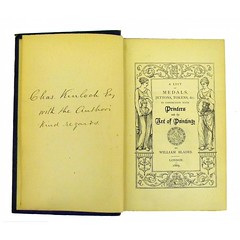

Blades and The Medal
Lot 30: an original copy of Blades on printers’ tokens & medals (1869)
Lot 38: a substantial run of the British Art Medal Society’s journal The Medal
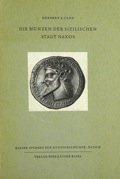
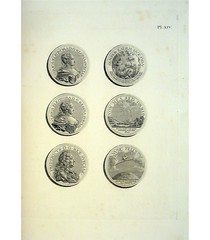
Naxos and Hedlinger
Lot 52: Herbert Cahn’s important 1944 work on the coins of Naxos
Lot 155: the complete Lockett sales, bound in two volumes
Lot 207: Mechel’s beautiful 1776-78 work on Hedlinger medals
Lot 225: a complete original set of Neumann on copper coins
Lot 253: a first edition copy of Pye on provincial copper tokens (1794-95) in an intriguing binding
Lot 256: an original copy of Ratto’s 1929 sale of the Claudius Côte Tarentine collection
Lot 298: the Montagu English coin sales, bound in one volume
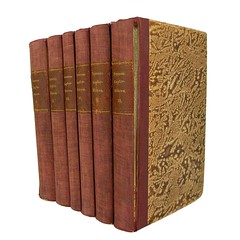

Neumann and Tornau
Lot 351: an original copy of Tornau on Mansfield (1937) in a special binding.
While the sale focuses on books about ancient and foreign coins, American collectors will find several lots to be of interest, including an interesting 19th-century Münz-Buch including American private and territorial gold (lot 102), volumes of the British Numismatic Journal including articles on American colonial coins (lots 44 and 45), a rare cambist featuring American coins (lot 170), and others.
The online sale is available now for browsing and absentee bidding at auction.numislit.com. A PDF of the catalogue can be downloaded for the convenience of the reader through the firm’s regular website at www.numislit.com. While bidders are encouraged to bid through the online platform, bids may be submitted through the traditional methods as long as any such absentee bids are received by Kolbe & Fanning by April 24, the day before the sale. Absentee bids may be placed directly online at any time prior to the lot being sold. On Saturday, April 25, beginning at noon eastern time, the sale will be conducted as a live internet auction.
Customers who have participated online in any of Kolbe & Fanning’s recent sales will be familiar with the bidding process. Others are encouraged to set up an iCollector account through auction.numislit.com and see for themselves how easy it is. Bidders wishing to participate in the live sale are strongly encouraged to register in advance.
Any questions may be directed to David Fanning at df@numislit.com or by phone at (614) 414-0855. We look forward to your participation.
SKLOW MAIL BID SALE #25 CLOSES JUNE 6, 2015
Below are the highlights for MBS # 25 Closing June 6th at 8 pm Mountain Time.
Catalog is now at the printing company, and will be shipped the beginning of May.
- The Early Auction Catalogs of Tom O'Mara.
- 1947 ANA Buffalo Convention Photograph.
- 1953 ANA Dallas Convention Photograph.
- 1954 ANA Cleveland Convention Photograph.
- Bangs, Merwin & Co. May 29, 1865 J.N.T. Levick Sale interleaved edition.
- Plated Low Sale of the Betts Collection January 11, 1898.
- Plated Sotheby, Wilkinson & Hodges Sale of the W.J. Davis Collection March 11, 1901.
- Raymond/Anderson Galleries Part I, II, & III of The W.W.C. Wilson Sales with beautiful reproduction plates.
- Original Crosby Early Coins of America 1875.
- Friedberg Gold Coins of the World, interleaved deluxe edition.
- Full Leather Newcomb Large Cents 1816-1857 thick paper edition.
- Full Leather Newcomb Large Cents 1815-1857 thin paper edition.
- Deluxe Quarter Leather Bust Half Fever Number 5 of 25.
- DeKnight 1900 second edition History of the Currency.
- Deluxe Hardbound American Numismatic Biographies by Pete Smith Number 13 of 25.
- Early volumes of the Numismatist [unbound] nice!
- Very Rare Early 1910 Official special badges of the ANA Convention.
- Trial Strike of the ANA Medal of Merit.
- The ANA Glenn Smedley Memorial Award.
- The ANA Medal of Merit.
- The Farran Zerbe Memorial Award to Louis S. Werner 1959.
- A three piece ANA 1947 Buffalo Convention medal set, bronze, silver & 10K gold.
- Rare ANA ephemera.
- Many ANA Convention medal sets.
- B. Max Mehl's James Ten Eyck Sale Catalog 1922.
- Deluxe Full Leather Private Gold Coins and Patterns by Don Kagin.
- Early Redbooks.
- Early Bluebooks.
- Many deluxe auction catalogs.
- Montea Imperii Byzaqntini by Wolfgang Hahn four volume set 1973, 1975, 1981, 1989.
- Financing an Empire: History of Banking in California 1927 four volumes by Ira Cross.
- Fabulous set of reproduction photographic plates from the W.W.C. Wilson Sale.
- Illustrium Imagines, 2001 Robert Weiss/George F. Kolbe.
- The United States Mint at Philadelphia 1903 by James Rankin Young.
- Trade Tokens of British & American Booksellers & Bookmakers, by Henry Morris [Bird & Bull Press], 1989.
- First Fine Silver Coinage of the Republic of San Serriffe, by Henry Morris [Bird & Bull Press], 1988.
- Many, many early auction catalogs.
- Many special Redbooks.
- And much, much more!
David Sklow-Fine Numismatic Books
P.O. Box 6321
Colorado Springs, CO 80934
PH: 719-302-5686
FAX: 719-302-4933
Email: numismaticbooks@aol.com
Web Site: FineNumismaticBooks.com

NEW BOOK: BALTIMORE’S PACKING & CANNING INDUSTRY
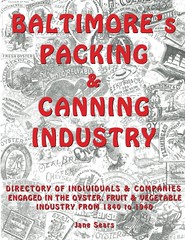 After years of extensive research, Jane Sears has completed her book on the Baltimore’s
Packing and Canning Industry, the city’s second largest industry in the late 1800’s and early 1900’s. The book begins in the first half of
the 19th century with the industry pioneers and goes up to 1940.
After years of extensive research, Jane Sears has completed her book on the Baltimore’s
Packing and Canning Industry, the city’s second largest industry in the late 1800’s and early 1900’s. The book begins in the first half of
the 19th century with the industry pioneers and goes up to 1940.
The largest chapter in the book, is a 120 page directory of the companies and people doing business in oyster packing and canning trade, and other supporting businesses, their locations, dates of operation and as many brand names as could be found. The author used city directories and other resources to get as much information as possible about this very important industry.
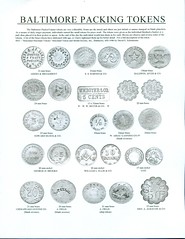 Included in the book are illustrations of packers and canners company owners, buildings, trade cards,
billheads, letterheads, statements, advertisements, envelopes (advertising covers), labels, badges, oyster express train schedule, revenue
stamps, trademarks and more. There are also illustrations of over 130 tokens.
Included in the book are illustrations of packers and canners company owners, buildings, trade cards,
billheads, letterheads, statements, advertisements, envelopes (advertising covers), labels, badges, oyster express train schedule, revenue
stamps, trademarks and more. There are also illustrations of over 130 tokens.
This book is highly recommended for Baltimore historians and is a great resource for those interested in genealogy, the history of the packing and canning industry and for collectors of items associated with the industry.
AVAILABLE AT AMAZON.COM Retail Price: $30.00
Wholesale price is available to retailers at Amazon.com
Black & White, 8.5” x 11”, 200 pages book
ISBN-10: 1508671060
ISBN-13: 978-1508671060
TO CONTACT THE AUTHOR ABOUT THIS BOOK
Her email is: MaryJaneSears1@gmail.com
Her assistant, Russ is: RussSears11@gmail.com
For more information, or to order, see:
Baltimore's Packing & Canning
Industry: Directory of Individuals & companies engaged in the Oyster, Fruit & Vegetable Industry from 1840 to 1940
(www.amazon.com/Baltimores-Packing-Canning-Industry-Individuals/dp/1508671060/ref=sr_1_1)
BOOKS AND COINS ROAD SHOW IN PHOENIX, NEW YORK
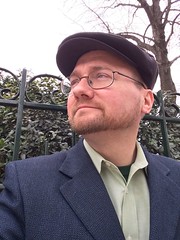 Dennis
Tucker, publisher of Whitman Publishing’s Guide Book of United States Coins (known as the “Red Book”), will give a presentation
Friday evening, May 15, at 7 p.m. at the Phoenix Public Library (34 Elm Street, Phoenix, New York). His illustrated talk will cover some of
the most popular and fascinating American coins and paper money, including World War II steel cents, Morgan silver dollars, Buffalo
nickels, and $20 gold pieces. Are those old coins in Grandpa’s cigar box worth a fortune? This will be a fun and educational lecture with
time for questions and answers about U.S. and world coins. Tucker will give away copies of the Red Book, Cash In Your Coins, and
other Whitman books, and will also share his story of growing up in Phoenix and eventually becoming the youngest publisher in the famous
Whitman Publishing firm’s 99-year history.
Dennis
Tucker, publisher of Whitman Publishing’s Guide Book of United States Coins (known as the “Red Book”), will give a presentation
Friday evening, May 15, at 7 p.m. at the Phoenix Public Library (34 Elm Street, Phoenix, New York). His illustrated talk will cover some of
the most popular and fascinating American coins and paper money, including World War II steel cents, Morgan silver dollars, Buffalo
nickels, and $20 gold pieces. Are those old coins in Grandpa’s cigar box worth a fortune? This will be a fun and educational lecture with
time for questions and answers about U.S. and world coins. Tucker will give away copies of the Red Book, Cash In Your Coins, and
other Whitman books, and will also share his story of growing up in Phoenix and eventually becoming the youngest publisher in the famous
Whitman Publishing firm’s 99-year history.
The next morning, on Saturday, May 16, from 10 a.m. to 1 p.m., Tucker will present a “Books and Coins Road Show” at the library, in conjunction with the ongoing Phoenix Community Garage Sale. Visitors are invited to bring in their coins and paper money for a free evaluation. Visitors with questions about their coins can email Tucker in advance at dennis.tucker@whitman.com, or simply bring them to the Phoenix Public Library on Saturday.
The Century Club was started in November 1914 by eight young women in the Village of Phoenix, New York, who decided to work toward civic betterment by establishing a public library.
Tucker, now living in Atlanta, studied political science and history at the University of Rochester (New York). He was honored in January 2015 by Governor Nathan Deal of Georgia for his career in book publishing and his promotion of the state’s history. As publisher at Whitman Publishing, he specializes in books on numismatics (the study of money), banking and financial history, the American presidency, U.S. military history, and other nonfiction topics. He has been a coin collector since the age of seven, and has written and lectured on coins, medals, and other collectibles.
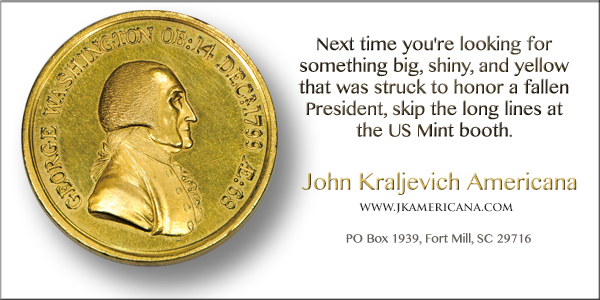
CBS FEATURES U.S. MINT ARTISTS AND ENGRAVERS
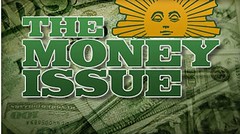 The show “CBS Sunday Morning” will air two segments this Sunday, 12 April, that may be of interest to you. The first segment will focus
on the artists and engravers in Philadelphia and the role they play in the coin-making process. The segment will also look at that
process, as well as some of the Philadelphia Mint’s history.
The show “CBS Sunday Morning” will air two segments this Sunday, 12 April, that may be of interest to you. The first segment will focus
on the artists and engravers in Philadelphia and the role they play in the coin-making process. The segment will also look at that
process, as well as some of the Philadelphia Mint’s history.
A second segment will look at the penny and the debate about whether or not it should be eliminated.
“CBS Sunday Morning” is hosted by Charles Osgood and airs at 9 am Eastern Time. Check your local listings to see when it airs in your region.
DESIGN: The look of currency
In a world obsessed with earning money, and spending it, it's understandable why you might not take a minute to examine your spare
change. But if you did, you might find those coins are miniature works of art. Anna Werner meets the man who designs our state quarters and
commemorative coins.
COINS: Making sense of pennies
Is the penny worth saving? Every year the copper coin buys less, while continuing to aggravate shoppers and cashiers. So should the U.S.
follow Canada's lead and dump ours?
Correspondent Nancy Giles explores the history and the pros and cons of the humble penny, the coin we love to hate.
To read the complete article, see:
CBS SUNDAY MORNING (www.anspocketchange.org/cbs-sunday-morning/)
For more information, see:
UP NEXT: APRIL 12, "The Money Issue"
(www.cbsnews.com/sunday-morning/show-notes/)
NOTES FROM E-SYLUM READERS: APRIL 12, 2015
More on the Franklin Mint Aftermarket
Brad Karoleff writes:
As far as Franklin Mint items that sell well, I have owned a couple of the Monopoly games issued by FM. They did not last very long at all in the store!
Ken Conaway writes:
In a blog post from 2013 I wrote about the set below. I have seen three of these sets come to market over the past five years and they command strong interest among not only ingot collectors but people with mining interests as well. Not many Franklin Mint examples in .999 silver.

Starting in the mid 1960's, the Franklin Mint made popular a new class of collectible precious metal; coins, medals and bars minted in silver, gold and platinum. Most were sold by direct subscription with one or two produced monthly over the term of production. Very few Franklin Mint examples were made in .999 silver, the vast majority produced in .995 silver, and generally much smaller in size than the set below.
I had seen these being individually sold and of course the combination of .999 silver and the commemoration of the ten largest and best known mines in the western United States caught my attention. Tom had given me a heads up on these early on and even though they weigh in at 4.16 oz each, they make a nice compliment to my 5 oz class collection.
The Franklin Mint Collection of Official Silver Ingots of the Great Western Mines were produced in 1973. 3,085 sets were made each containing 10 examples, 2,000 grains each or the 4.16 oz noted above. Subscription charge new was $25 each.
To read the complete article, see:
The "F" Box Part I
(http://silveringot.blogspot.com/2013/05/the-f-box-part-i.html)
To read the earlier E-Sylum article, see:
THE FRANKLIN MINT AFTERMARKET (www.coinbooks.org/esylum_v18n14a07.html)
Query: Who Bought Cleneay 1797 Half Dollar?
Dave Stone of Heritage Auctions writes:
I need help from the readers to determine if Byron Reed purchased the Mint State 1797 half dollar in lot 1104 of the Thomas Cleneay Collection (S.H. & H. Chapman, 12/1890). The Cleneay plates show some similarities and some differences when compared to the Reed plates, so I am hoping someone has a named sale that could definitively answer this question. Thanks for any help you can give me.
Correction: Washington University in St. Louis
In the video interview I gave in Baltimore about the Newman Numismatic Portal project, I slipped up on the name of Washington University in
St. Louis, starting my reference incorrectly with "University of Washington". Sorry. Unlike a text article we can't easily
correct the video. It's Washington University in St. Louis, or "WUSTL" for short.
To read the earlier E-Sylum article, see:
NEWMAN NUMISMATIC PORTAL INTERVIEW MARCH 2015
(www.coinbooks.org/esylum_v18n14a04.html)
CoinWeek Interviews Harvey Stack on Great Collections
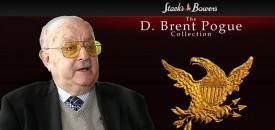 On March 26, Stack’s Bowers founder and numismatic luminary Harvey Stack sat down with CoinWeek editor Charles Morgan to discuss
numismatic history in the making, the upcoming sale of the D. Brent Pogue Rare Coin Cabinet. Harvey, whose career spans more than sixty
years, grew up in the business and has been at the center of many of the 20th and 21st century’s most celebrated rare coin sales. He shares
with CoinWeek his thoughts about the Stack’s Bowers brand and why great collections always seem to end up “on the block” at a Stack’s
Bowers auction. Harvey also shares his opinions about the upcoming historic sale of the D. Brent Pogue Rare Coin Cabinet.
On March 26, Stack’s Bowers founder and numismatic luminary Harvey Stack sat down with CoinWeek editor Charles Morgan to discuss
numismatic history in the making, the upcoming sale of the D. Brent Pogue Rare Coin Cabinet. Harvey, whose career spans more than sixty
years, grew up in the business and has been at the center of many of the 20th and 21st century’s most celebrated rare coin sales. He shares
with CoinWeek his thoughts about the Stack’s Bowers brand and why great collections always seem to end up “on the block” at a Stack’s
Bowers auction. Harvey also shares his opinions about the upcoming historic sale of the D. Brent Pogue Rare Coin Cabinet.
To read the complete article, see:
Harvey Stack Talks Pogue and
Other Great Collections – Video: 9:24
(www.coinweek.com/coin-shows/harvey-stack-talkes-pogue-and-other-great-collections-video-924/)
Charles Stake Follow-Up
Dave Hirt writes:
I just want to thank everyone who responded to my request for information on Charles Stake. As usual, it shows the vast reservoir of numismatic knowledge of our readership.
To read the earlier E-Sylum article, see:
MORE ON COIN DEALER CHARLES L. STAKE
(www.coinbooks.org/esylum_v18n14a10.html)
ANA Exhibit Applications Accepted
Numismatic bibliophiles! It's not too soon to start planning an exhibit for the August 11-15, 2015 American Numismatic Association
World's Fair of Money. I hear that applications are now being accepted, and the deadline is June 19.
For more information, see:
CONVENTION EXHIBITS
(www.money.org/numismatic-events/convention-exhibits)
JOHN DANNREUTHER AND THE 1808 QUARTER EAGLE
John Dannreuther writes:
 On the way to the Central States show, Jimmy Hayes asked me to meet him in Kansas
City (I had to go through there to get to the show in Cedar Rapids), so I arranged several hours for the layover. I met Jimmy at the
airport and Dr. Ketterman picked us up in his Thunderbird. We went to his bank and Jimmy gave them a cashier's check and they
delivered the gem 1808 quarter eagle.
On the way to the Central States show, Jimmy Hayes asked me to meet him in Kansas
City (I had to go through there to get to the show in Cedar Rapids), so I arranged several hours for the layover. I met Jimmy at the
airport and Dr. Ketterman picked us up in his Thunderbird. We went to his bank and Jimmy gave them a cashier's check and they
delivered the gem 1808 quarter eagle.
Dr. Ketterman said he wanted to show us some other coins, so we headed to another bank. Once there, we viewed his gem 1796 dime, a superb cameo Proof 1831 quarter eagle, and another coin that I don't remember. As we were leaving the bank, one of the famous Kansas City downpours was happening. I slipped on the sidewalk and my elbow broke my fall. The fall broke my elbow, too!
After getting in the car, I nearly passed out from the pain, so we went to Dr. Ketterman's office, took an X-ray, where he noted it was a clean break. He put it in a cast, then took us to the airport and we headed to Cedar Rapids for the Central States coin show. I was in the cast for a few weeks and, of course, had a great story.
To read the earlier E-Sylum article, see:
SELECTIONS FROM THE POGUE COLLECTION, PART I : Lot 1128: 1808 Capped Bust Left
Quarter Eagle (www.coinbooks.org/esylum_v18n14a12.html)
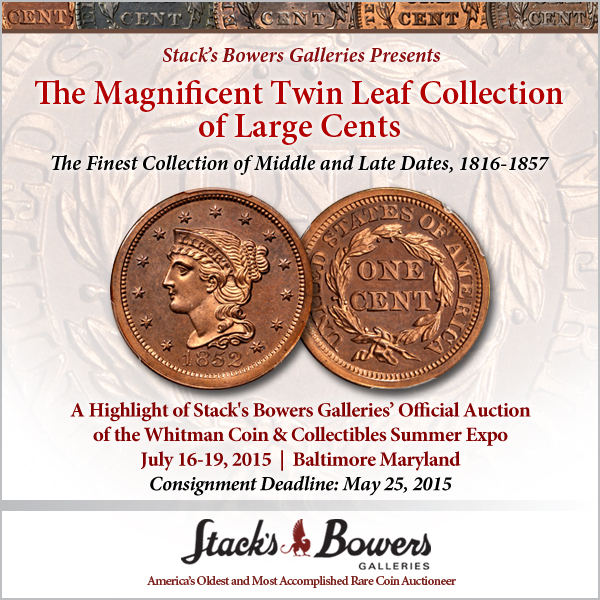
REPORTER'S THOUGHTS ON TOMMY THOMPSON'S CAPTURE
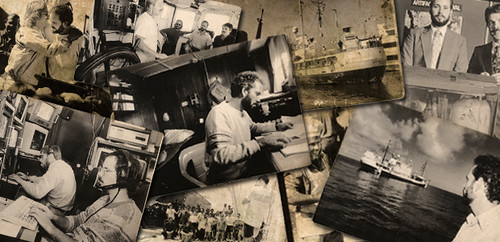
The morning in January when news broke that federal fugitive Tommy Thompson had been arrested, after more than two years on the lam, no fewer than 10 people approached me, called me, even texted me to relay their “Did you hear?!” and express excitement and disbelief. I, too, was surprised, but not just that they’d found the former hometown hero. I was shocked—disappointed even—by where they’d found him: a hotel room in Boca Raton, Florida. You’ve got to be kidding. Not only was he still in the U.S.—it had been widely rumored he was abroad—but he was less than 100 miles from his last known address. He had been hiding in plain sight.
I spent the better part of last year researching for a story about Thompson, a Columbus engineer who made history in 1989 when he and a crew of scientists and seamen hauled nearly 3 tons of gold from a historic shipwreck on the ocean floor. (My 17-page story about Thompson and the aftermath of his momentous discovery, “Man Overboard,” made the cover of our November 2014 issue.) I talked to people who knew him when he was a brainy kid in Defiance, Ohio. I talked to those who were at sea with him when he and his crew discovered the SS Central America, a wood-hulled steamship that sank in 1857 with tons of gold in its hold. And I talked to the Columbus tycoons whom Thompson convinced to invest millions in his dubious mission.
The story of Thompson and the ship of gold gripped Columbus then and continues to hold tight now, thanks in large part to the two-year manhunt, now over, for Thompson and his assistant, Alison Antekeier, who disappeared after a federal judge in Columbus ordered them to appear in court.
I’d imagined him living abroad, sailing from place to place. I wouldn’t have been surprised to learn he had been found living in a rainforest or on a remote island somewhere and had established a self-sustaining community that had power and running water.
After spending so much time reading, thinking and talking about Thompson, I’d built him up to be a sort of mythical character in my mind. And, after poring over court records filled with testimony from and about Thompson and holding hours of conversation with people who knew him well, I never saw him as the crook he’s often portrayed to be. I see him instead as a smart guy who did an extraordinary thing and wasn’t prepared for the onslaught of legal minutiae that followed. I’m not condoning his behavior, but I don’t think it was premeditated. Perhaps the pressure truly drove him mad. That’s all very easy for me to say—he didn’t take any of my money.
Investor Don Garlikov thinks Thompson and the directors who helped manage the money did everything they could to protect the investors. He sees Thompson as a victim.
“We’re in a sad state of affairs,” Garlikov says. “This shouldn’t have happened in the first place. It was done for the wrong reasons.”
To read the complete article, see:
Reporter’s Notebook:
Hunting Tommy Thompson (www.columbusmonthly.com/content/stories/2015/04/reporters-notebook-hunting-tommy-thompson.html)
REPORTER'S NOTEBOOK ON THOMPSON ARRAIGNMENT
Everyone standing in the federal courtroom Wednesday held his or her breath as the Columbus treasure hunter-turned-fugitive Tommy Thompson, shackled at the wrists and ankles and wearing an orange jumpsuit, shuffled in. Or maybe it was just me. The frail 62-year-old man, with curly, graying hair and a thick beard, is a virtually unrecognizable version of the handsome, dark-haired engineer who made history in 1989 when he discovered a sunken ship off the Carolina coast and hauled up nearly 3 tons of gold.
The hot and stuffy room had filled nearly to capacity in anticipation of Thompson’s appearance. The usual suspects—lawyers and business types buttoned up in suits, reporters scribbling in their notebooks—lined rows of benches, but there were others, too. A handful of folks who appeared to have personal connections to Thompson—relatives, perhaps—congregated to one side.
Though Thompson’s movements and speech during the arraignment were slow, his wide eyes darted quickly around the room, surveying faces in the large audience. He clearly recognized some, including his old friend Bob Evans, who helped him discover and recover the lost treasure of the SS Central America. Thompson even briefly greeted his old friend Bob as he exited the courtroom after the hearing.
Guilty pleas from Thompson and Antekeier were expected. In March, they each agreed to plead guilty and to account for missing assets, including the whereabouts of 500 missing gold coins. Thompson’s deal requires him to forfeit $425,380 in cash—the amount he was carrying when he was arrested—and to identify anyone who helped him while he was on the run. In exchange, his sentence was limited to a maximum two years in prison and a maximum fine of $250,000. Antekeier’s sentence was limited to a maximum of one year in prison and a $100,000 fine. Sentencing dates have not been set.
To read the complete article, see:
Reporter’s Notebook:
Seeing Tommy Thompson (www.columbusmonthly.com/content/blogs/the-latest/2015/04/tommy-thompson-arraignment-ship-of-gold.html)
STATEMENT ON BEHALF OF TOMMY THOMPSON
“We hope this plea agreement today is a first step toward ending a decade of lawsuits and refocusing efforts on finding and recovering more deep ocean shipwrecks like the SS Central America,” said Benjamin Dusing, attorney for Thomas G. “Tommy” Thompson, ocean explorer, marine engineer, inventor, and entrepreneur.
As part of the plea agreement between Douglas W. Squires, assistant US Attorney, Thompson, and Dusing, Thompson agreed to forfeit $425,380 seized when he was arrested, to help identify and recover assets and answer questions under oath about those assets, and to identify others who may have helped him in the crime of contempt.
If Thompson complies with terms of the plea agreement, the US Attorney for the Southern District of Ohio agrees not to charge him with any other offense arising out of the case. The agreement carries a maximum prison term of two years and a maximum fine of $250,000.
“Legal disputes over the first shipwreck Thompson’s team discovered, the SS Central America, have clouded Columbus-America’s bright beginning,” Dusing said. “First it was 39 insurance companies who claimed they had insured the cargo of the SS Central America,” he said. Several later cases were filed by two of more than 200 investors, and by members of a sonar team who helped in the search, he added.
In the mid-1980s, Thompson formed Columbus-America Discovery Group to locate, explore and recover the sunken treasure of the SS Central America, lost in an 1857 hurricane off the Carolina coast with the loss of 425 lives and a commercial shipment of some three tons of gold.
“Tommy Thompson succeeded because he did things no one had ever done before,” Dusing said. “He developed and adapted tools, techniques, and processes to locate and recover the SS Central America from a depth of 8,500 feet.”
Dusing cited several examples to illustrate Thompson’s entrepreneurial creativity.
1. Thompson engaged historical researchers to dig through 130-year-old newspapers to build a wall-sized Data Correlation Matrix of useful information.
2. He contracted with a theoretical mathematician to use the historical data to develop a probability search map of the Atlantic Ocean.
3. And he used that map to direct the use of wide-swath sonar over 1400 square miles of ocean to locate a badly degraded wooden hull shipwreck.
Though these methods were not new, no one had ever creatively adapted historical research, or mathematic search theory, or side-scan sonar in this manner before. This approach led to Columbus-America receiving an Institute of Management Sciences award.
Tommy then redirected Columbus-America toward engineering. They invented and built a revolutionary deep submergence vehicle-Nemo, to be the eyes, ears and arms of the scientists and engineers who operated it from a surface vessel 8,500 feet above.
Columbus-America continually adapted and improved Nemo, equipping it to perform both heavy excavation and extremely delicate tasks. Using the submersible technology they invented, Tommy and Columbus-America established the first “working presence” in the deep ocean, and carefully excavated the S Central America while preserving its historical resources. Thompson has a continuing concern about protecting the site of the SS Central America.
KELLOGG AND HUMBERT ASSAY INGOT OFFERED
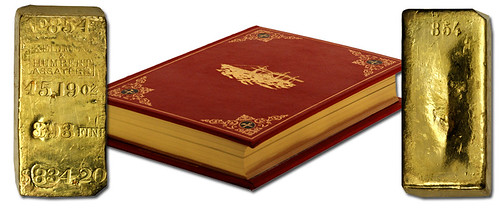
In September, 1857, the side-wheel steamer, S.S. Central America, laden with freshly minted gold coins (primarily $20 double eagles) and other relics of the gold fields was caught in a hurricane off the coast of South Carolina, while making its way up the Atlantic en route from Panama to New York. The ship sank to the ocean floor and her precious cargo never made it to New York, exasperating the already weak economy. This week’s highlight from our New York Rarities Sale, being held on May 20, 2015 at Sotheby’s Galleries, comes from this recovered treasure.
The wreck was discovered in September 1988 by Tommy Thompson and the Columbus America Discovery Group. Using state of the art equipment, they located and recovered a large quantity of gold coins and ingots from the ocean floor. Among them was this impressive Kellogg & Humbert 45.19 ounce gold ingot.
Mr. Bowers penned a massive reference work on the history of the Gold Rush, with special focus on the S.S. Central America. A small number of “special editions” of this book were produced and given to those who purchased certain private ingots such as the Kellogg and Humbert example we are offering. For those interested in the history of the Gold Rush, no relic is more impressive than these large gold bars, and this fantastic reference book by Q. David Bowers. This is an important opportunity.
In his description of this lot for the catalog, James McCarthy states:
“Fully bright medium gold, the surface is free of any noteworthy imperfections. Close inspection reveals insignificant abrasions and a minor texturing that is more the result of the casting process than time spent at sea. The top of the ingot is stamped NO 854 with the name of the firm, KELLOGG / & / HUMBERT / ASSAYERS, within a rectangular box below. Midway down the bar is the weight, 45.19 OZ, followed by the fineness, 893 FINE, and the value in gold at the time of manufacture, $834.20. Considering that the current market price dictates a bullion value of nearly $54,000, much can be inferred about our economic change and growth over the past 150 years! Assuming medal-turn, the back side is also stamped 854 at the top, remaining otherwise blank. Housed in a clear acrylic case, the ingot is easily viewable from all sides and is thoroughly protected from harm.
“Also included with this ingot is a deluxe gilt and leather-bound copy of A California Gold Rush History by Q. David Bowers, complete with dust cover. Measuring 14 in. x 11 in. x 2.75 in., this incredible wealth of knowledge provides an insightful and entertaining narrative outlining the context and events surrounding the California Gold Rush of the mid 19th century. Using the fateful voyage of the S.S. Central America as a lens of discussion, the author guides you through why this era remains both an enchanting and important time in our nation's history. Numbered 340 of out 400 and containing a sample of gold dust recovered from the S.S. Central America integrated into the inside cover, this compilation is a perfect companion to this marvelous ingot. Both items are sure to be enjoyed and appreciated by generations to come!”
To read the complete article, see:
Historic and Extremely Rare Assay Ingot from the wreck of the S.S. Central America (www.stacksbowers.com/NewsMedia/Blogs/TabId/780
/ArtMID/2678/ArticleID/65082/Historic-and-Extremely-Rare
-Assay-Ingot-from-the-wreck-of-the-SS-Central-America.aspx)

ANOTHER 1933 DOUBLE EAGLE SIGHTING REPORTED
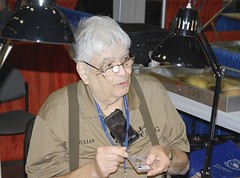 Silver Spring, Md., dealer Julian Leidman credits his mother with cultivating his interest in coins when he was 11. His parents tried first
with stamps, but that never took hold. Leidman enjoyed looking through his coins, filling holes in his Whitman coin folders, trading or
selling his duplicates with friends as well as with Charles French, a local coin dealer in Troy, N.Y.
Silver Spring, Md., dealer Julian Leidman credits his mother with cultivating his interest in coins when he was 11. His parents tried first
with stamps, but that never took hold. Leidman enjoyed looking through his coins, filling holes in his Whitman coin folders, trading or
selling his duplicates with friends as well as with Charles French, a local coin dealer in Troy, N.Y.
French had a national coin auction business, and he and his associate, Les Zeller, helped foster Leidman’s burgeoning numismatic interests.
The Leidman family moved to the suburban Washington, D.C., area while he was in high school. In his new surroundings, he met future lifelong friend Albert L. Bonan, who had started a coin business with his father. Leidman said he eventually took over Bonanza Coins.
As he extensively traveled to coin shows and auctions, Leidman said, he developed an interest in higher graded early U.S. coins and patterns.
Along the way, he met Q. David Bowers, Jim Ruddy, Jerry Cohen, the Stacks (Harvey, Norman and Ben), and Lester Merkin.
In the early 1970s, Leidman said, he became close with Mike Brownlee, Stan Kesselman, and Harry W. Bass Jr.
In 1975, Leidman and Brownlee met with Kesselman in California to purchase a collection of Coronet and Saint-Gaudens $20 gold double eagles from noted collector R.D. “Ted” Naftzger. The collection was eventually sold to Jeff Browning, one of Brownlee’s customers.
Leidman said he had been left back at the hotel while the deal was consummated, but was able to look through the coins upon Brownlee and Kesselman’s return.
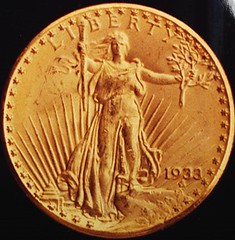 “When they returned to the hotel, they left the coins with me, except they took one coin and wouldn’t let me see it and went and got some
lunch,” Leidman said. “I was looking thru the coins, desperate to see the secret coin, when they came back. They had actually left the
secret coin in the 1927 envelope as it was the commonest date at the time and knew I wouldn’t have bothered to look at it. The secret coin
was a 1933 [double eagle]. Jeff purchased the coin, as well. Unfortunately, he died at a very young age, and his collection remained unsold
until 2001.”
“When they returned to the hotel, they left the coins with me, except they took one coin and wouldn’t let me see it and went and got some
lunch,” Leidman said. “I was looking thru the coins, desperate to see the secret coin, when they came back. They had actually left the
secret coin in the 1927 envelope as it was the commonest date at the time and knew I wouldn’t have bothered to look at it. The secret coin
was a 1933 [double eagle]. Jeff purchased the coin, as well. Unfortunately, he died at a very young age, and his collection remained unsold
until 2001.”
In 1976, Leidman said, he was able to purchase $1 million of the Wilkison gold patterns from A-Mark, including the six-piece 1872 Amazonian gold pattern set. Leidman said he sold the Amazonian gold pattern set in 1983 in a private transaction.
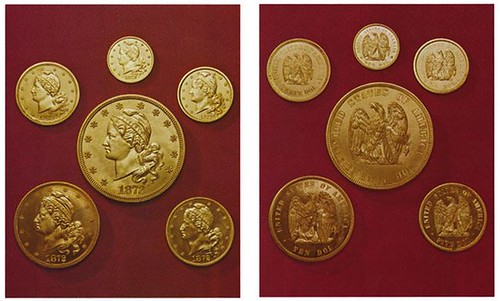
1872 Amazonian gold pattern set
Leidman said upon Browning’s death, the 1933 double eagle went to a friend of his that had a minor interest in the entire collection. “It was subsequently sold in the 1980s to the anonymous collector that now owns it,” Leidman said.
To read the complete article, see:
United States pattern coins
specialty for professional numismatist Julian Leidman
(www.coinworld.com/insights/julian-leidman-specializes-in-united-states-pattern-coins.html)
JUDGE RULES IN ALUMINUM CENT CASE
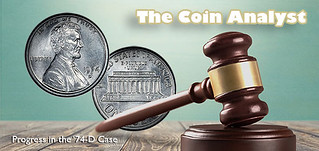 It looks like Heritage might get to auction that unique 1974-D aluminum cent after all…
It looks like Heritage might get to auction that unique 1974-D aluminum cent after all…
Intended to be one of the highlights of Heritage Auctions’ 2014 Central States Numismatic Society Convention Sale, a 1974-D aluminum cent pattern once belonging to an assistant superintendent at the Denver Mint, has been tied up in litigation for more than a year. On March 26, a United States District Court Judge issued a ruling that may clear the way for the coin’s sale.
In 1973, with copper bullion costs on the rise, the U.S. Mint authorized a series of experiments designed to test the feasibility of alternate planchet compositions for the one-cent coin.
It was during these tests that the U.S. Mint struck more than one million aluminum one-cent coins, all bearing the date 1974.
Until last year, most numismatists were unaware of the fact that aluminum cents were also struck at the Denver Mint. The discovery was made after Randall Lawrence, son of the late Henry Lawrence, who served as Assistant Superintendent of the Denver Mint at the time when the experimental coin was struck, sold the specimen to San Diego-based coin dealer Michael McConnell for an undisclosed sum.
Although no records of the striking survive, reports published on various numismatic websites speculate that between 10 and 14 examples may have been struck. Since the discovery of the Lawrence specimen, no further examples have come forward.
The uniqueness of the 1974-D aluminum cent drew immediate collector interest and national attention. But it also drew unwelcome scrutiny from the United States Mint, which filed suit in Federal Court on March 14, 2014. Seeking the return of the pattern, the Mint alleged that coin’s production was unauthorized and that it was never released to the public.
The government used a similar tactic in 2005 to seize 10 1933 double eagles from the heirs of Philadelphia coin dealer Israel Switt. It is believed that Switt was the source for nine 1933 double eagles that had been sold in the years immediately following the government’s recall of gold coinage.
Federal judge William Q. Hayes, agreed with the Plaintiffs, and rebuffed the government’s position, stating that Lawrence could have been given the coin, as claimed, by Mint officials and that his heir’s claim of legal ownership was “plausible” through the drawing of “reasonable inferences.”
Should the government decide to no longer pursue the issue, the controversial 1974-D cent pattern will be cleared to make an appearance on the auction block no worse for wear, and perhaps even more coveted due to its complicated legal history.
To read the complete article, see:
The Coin
Analyst Federal Judge Rules Against Government In 1974-D Aluminum Cent Case
(www.coinweek.com/coins/news/the-coin-analyst-federal-judge-rules-against-government-in-1974-d-aluminum-cent-case/)
To read the earlier E-Sylum articles, see:
GOVERNMENT DISPUTES 1974-D ALUMINUM CENT OWNERSHIP
(www.coinbooks.org/esylum_v17n12a17.html)
FIGHT CONTINUES OVER 1974-D ALUMINUM CENT
(www.coinbooks.org/esylum_v17n36a27.html)
BRUCE H. SMITH VISITS TUTTLE MUSEUM
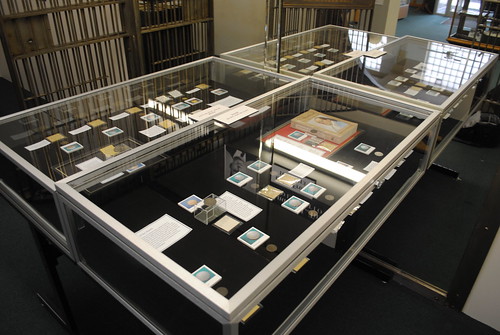
Andrew Tuttle was an enigmatic character and inveterate collector. He was killed in an automobile accident in 2003 and in his handwritten will left his collections to the city of Defiance with the stipulation that the city establish a museum named in his honor. This has been done, although his bequest took everyone by surprise. He had no family, and I was told that when he died the emergency contact found in his wallet was for a high school classmate he hadn't seen since their graduation in 1937. He was a traveler, and there are some interesting letters from abroad displayed in the museum. One is from a dissatisfied coin dealer in Sri Lanka putting a curse on him.
The colonials are displayed in two cases in the vault of the museum which once housed a bank. There is a nice representation of colonial material, but not all of the holdings are on display. Also, the colonials are only a small part of the coin collection. In an adjacent case are some "odd and curious" items. Displayed along with the coins are Tuttle's annotated 2 X 2 envelopes. Many of them show Stack's and Coin Galleries provenance. The Virginia piece was from the Donald L. Rhodes sale of 1958 with which I was not familiar. Most of what is in the cases appeared to have been collected in the late 50s into the 60s.
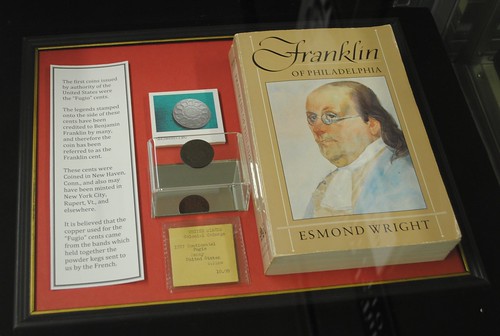
I spoke with the City Historian and one of the curators. They were receptive to having a more thorough study of the collection done. They said that that know little about the coins and would welcome information. I left them a spare copy of Crosby. I was also told that Mr.Tuttle had formed his collection with the assistance of Steve Davis. He's helped the museum deaccession some material, no colonials, and another auction is scheduled for later this year.
I thought things were well chosen by Mr. Tuttle. The Virginia and Rosa Americana were uncirculated. The Baltimore was lower grade. Most of the rest of the copper was nice VF-XF looking with good surfaces. Whether the coins not on display are equal in condition, I'll have to wait to find out.
A draped bust dollar was included as example of an early U. S. mint coin. It looked F - VF, and I have no idea if it was a scarcer variety.
It was essentially a nice type set. Single examples of state coinages (Vermonts, African Head, A NJ I recognized but don't know), Nova Eborac, Kentucky, a Pillar 8 R, a George III guinea, a small U. S. Constellatio. The photos show the Virgina halfpenny, Rhode Island Ship Token, Rosa Americana, and the Lord Baltimore pieces. Those were probably the nicest coins. I didn't try to identify anything by variety except for the few I knew. No MA silver, no St. Pat's, nothing I saw as really rare, on display at least.
The people were very nice. Who knows what might be there. In any case it's good to know a place like this exists. It certainly helps bring colonial coins to an audience that may otherwise never know of their existence.
Steve Davis of Numismatic Auctions L.L.C. adds:
I am in a multi-year contract offering duplicates and non-display items with the Tuttle Museum. I sold some wonderful material from the collection in my last Auction Sale #56 including a Gobrecht Dollar and a 144pc collection of US Commemorative Half Dollars. I am auctioning some fine Latin American Coinage, Patterns and Cut and Countermarked coinage from the museum holdings in my June 29, 2015 Auction Sale #57.
To visit the Numismatic Auctions web site, see:
www.numismaticauctionsllc.com
Jeff Starck of Coin World adds:
The city of Defiance’s passage of an “emergency” ordinance to allow the sale. The money apparently was going to be used by the museum board, based on a reading of the ordinance.
To read the complete article, see:
ORDINANCE NO. 7663
(www.cityofdefiance.com/main/images/council/legislation/2014/9-23-14.pdf)
To read the earlier E-Sylum article, see:
DEFIANCE BANK BUILDING HOUSES TUTTLE MUSEUM
(www.coinbooks.org/esylum_v18n14a24.html)
THE BOOK BAZARRE
DAVISSONS LTD. ANNOUNCES E-AUCTION 9
Davissons Ltd. of Cold Spring, Minnesota announces E-Auction 9, closing Wednesday, April 29, a live internet and mail bid sale posted on their website, www.davcoin.com. As with all Davissons auctions this sale has no buyer’s fee.
This 100 lot sale features a selection of higher quality items, in addition to a range of attractive pieces at affordable estimates to appeal to a broad range of collectors. Some highlights include:
*A run of mints of Edward I and a sampling of the different coinages of Elizabeth I
*Attractive Greek silver including a high grade early New Style tetradrachm of Athens and some BCD pieces of Sicyon

Lot 11: ATTICA. Athens. AR tetradrachm. New Style coinage. 187/6 B.C. Good Extremely Fine. Estimate: $800
* Greek bronzes from stock held in the back of the safe for many years—better material for the dollar than much of what is available now
*Judaic coinage from the era of the New Testament
*Late Roman in minty condition
*A few British Celtic pieces including two mint state pieces from a recently acquired collection
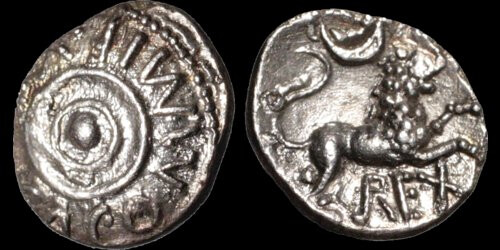
Lot 42: CELTIC BRITAIN. Southern: Regini and Atrebates. Verica. Circa A.D. 10-40. AR unit. Mint State. Estimate: $400
*A few appealing milled pieces
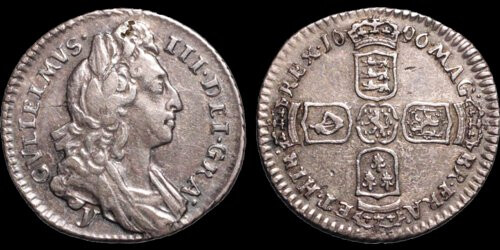
Lot 76: William III. 1696/o – variety unlisted in ESC. 1694-1702. AR sixpence. 1696/o – variety unlisted in ESC. Good Very Fine. Estimate: $150
*Some high grade “Conders”
*A couple beautifully toned US commemorative halves from a small collection that had been stored in a Wayte Raymond board for several decades
*Four striking medals including the final two City of London medals out of a consignment offered over the course of the last few auctions, and two Mint State Napolean medals
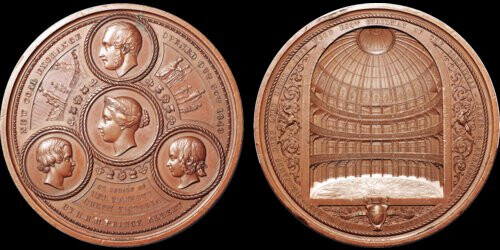
Lot 99: Corporation of the City of London. Coal Exchange Opened 1849. Æ. 90 mm. Interior of the Coal Exchange with three dimensional
perspective achieved by designing depth into the medal. Good Extremely Fine. Estimate: $400
A family business composed of Allan, Marnie and Lief Davisson, Davissons Ltd has been in business for over 40 years. Their goal with every E-Auction is to provide interesting and unusual pieces at conservative estimates. “It doesn’t have to be expensive to be interesting!”
The sale is posted on their website, www.davcoin.com where you can bid live. You may also request a print catalog. Contact them or bid by emailing info@davcoin.com or fax (320) 685-8636 or phone (320) 685-3835, or mail at PO Box 323, Cold Spring MN 56320 USA.
CUBAN COINAGE STRUCK AT THE PHILADELPHIA MINT
The Cuban Monetary Law was signed on October 29th, 1914. The Law was very specific, detailing not only the amount of coins to be issued with their values, but also their metal composition as well as their thickness, weight and diameter.
Article VII of the Law reads in part: “Every coin shall be stamped with its value, weight and fineness, year of coinage, and the inscription “Republica de Cuba”, and the gold coins shall bear, besides, the effigy of Marti, and on the reverse the escutcheon of the Republic. Silver and nickel coins shall have stamped on the reverse the escutcheon of the Republic and on the obverse a five point star. Gold coins of five, ten and twenty pesos shall be of the same shape, weight and value as the corresponding coins of the United States of America, and those of four, two and one peso shall be proportionate to the above size and weight.”
We can positively ascertain from the above the correct obverse and reverse of these coins, which is not how it is shown on some Catalogs.
On December 3, 1914 Mr. Charles A. Conant, of New York, and representing the Cuban Government, writes to Mr. Charles E. Barber at the U.S. Philadelphia Mint asking for his interest in engraving the dies for the new Cuban coinage.
Barber replies on December 4th, indicating his vast experience in this matter “…we have made the dies for coinage for almost all the Central and South American countries, besides those for Panama and the Philippine, therefore can claim a pretty wide experience in this line. For about forty years we have made the dies for the coinage of the United States…”
Conant and Barber meet in Philadelphia on December 9th, and Barber follows up with a letter sent on the 10th. where he indicates “I will agree to furnish for approval sketches for both obverse and reverse using such material as you are able to supply…” also indicating “I will make the necessary models, matrixes and hubs for the reproduction of the working dies…”
On December 19th, 1914 Mr. Leopoldo Cancio acting as Cuba’s Secretary of Treasury notifies Conant “After careful consideration, and having consulted with the President about the different points brought up by the artists, I have decided to accept Mr. Barber’s proposition as it seems to me that his familiarity with coinage at large will give best results.” Cancio further indicates “You are hereby directed to order the execution of the work in accordance with Mr. Barber’s proposition of December 10, 1914. It is understood that sketches must be submitted for approval previous to the final execution of the work.”

For more information on the Cuban Numismatic Association, see:
http://cubanumis.com/
IDENTIFYING MEDALS FROM A PHOTO OF THE DIE
NEW ARCHIVE TERM: 'DIE FLIPPED-PHOTO'
If you do not have a struck specimen handy, but you have access to the die, can you take a satisfactory photo of the die for archive purposes?
The answer is yes provided you flip the photo to show the positive image.
That was proved to me this week when I asked the archivist at Medallic Art Company to send me a photo of one of Milton Horn's plaquettes in his Medical Heritage Physician Series, the Physician as Teacher. Here are the two for comparison:
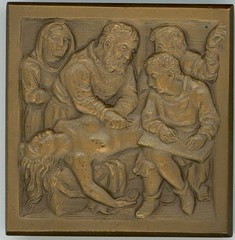
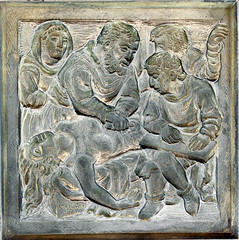
Struck Specimen and Photo of the die (flipped)
Other than color in the two photos there should be no difference in the image. Satisfactory for identification purposes.
Thanks to Joe Levine for the photo of the struck specimen, and to Cathy Swinburg for the die flipped-photo. It is Medallic Art Company's catalog number 1971-150-002.
THE BOOK BAZARRE
Dale Seppa , 103 N Sixth Avenue , Virginia, MN 55792. hpd1940@aim.com
AMERICAN PLANTATION TOKENS
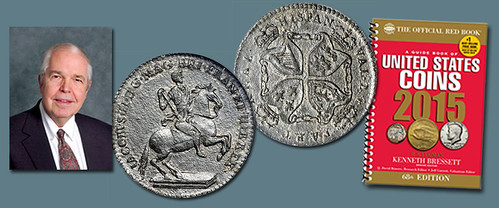
Returning to this week’s topic, American Plantation tokens, these were authorized by King James II, who in August 1688 granted a patent or franchise to Richard Holt, an agent who represented the owners of several tin mines. Holt proposed that new issues for the plantations in America be made of tin and be of Spanish monetary designation to facilitate their acceptance in the New World. By that time Spanish-American coins were dominant. The value assigned to these pieces, 1/24th of a real was equal to about 1-1/2 farthings, or somewhere between a British quarter penny and half penny.
The dies were cut by John Rottier, one of England’s most famous engravers. In 1964 Eric P. Newman, a leading scholar in the colonial series, created a study for the American Numismatic Society that identified seven obverse and seven reverse die varieties, indicating that the coinage must have been extensive. He was not able to find anything about the distribution, and it is not thought that they were widely circulated in America, although one was excavated in Jamestown, Virginia.
The obverse of these tokens shows James II on horseback, surrounded by a Latin inscription. On the reverse are four heraldic shields. Today American Plantation tokens are occasionally encountered, most being restrikes made of Newman die combinations 4-E and the more plentiful 5-D. These were made in a pewter-like metal and not in nearly pure tin like the originals. Originals often display black oxidation called “tin pest” from the metal being subjected to low temperatures. Restrikes sometimes have oxidation, but mostly have bright surfaces. The rims are often irregular. While such pieces can be collected by varieties, most numismatists are satisfied to own one example to illustrate the type.
To read the complete article, see:
A Tour Through A Guide Book of United States Coins, Part Eleven (www.stacksbowers.com/NewsMedia/Blogs/TabId/780/
ArtMID/2678/ArticleID/65080/A-Tour-Through-A-Guide-Book
-of-United-States-Coins-Part-Eleven.aspx)
ROBERT LOVETT SR'S 'PASSAGE OF THE DELAWARE'
Dave Baldwin writes:
I picked up something a few months ago that I thought might be of interest to your readers. I was doing a Google search for "Robert Lovett Sr" and ended up finding an embossed monochrome cameo print done by him and it was for sale! It is pictured on my website. Although not a numismatic item it is one of my favorite pieces now.
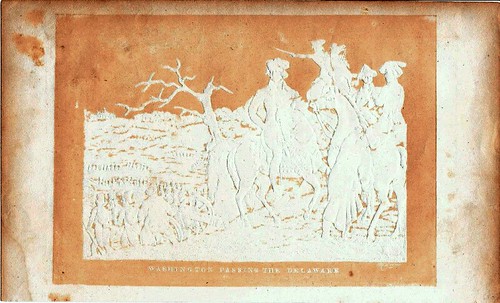
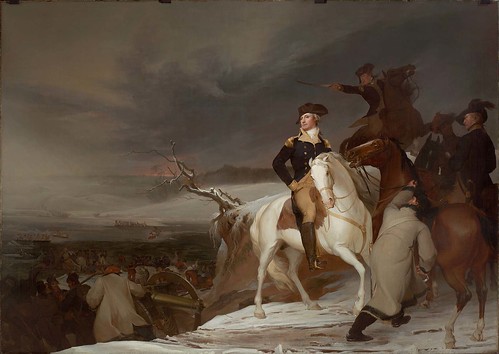
This print is after Thomas Sully's painting of an iconic moment in American history. Entitled "The Passage of the Delaware" it depicts George Washington the moment before he dismounts and begins his crossing of the Delaware River. The title below the image reads "Washington Passing the Delaware" and in the lower right hand corner is "R Lovett".
For information on this painting, see: The Passage of the Delaware (www.mfa.org/collections/object/the-passage-of-the-delaware-31231)
To read the complete Lovett web page, see:
Jesse D. Elliot Tribute Medal to James Fenimore Cooper
(www.lovetttokensmedals.com/RobertSr/OddFellowsHall.html)
THE BOOK BAZARRE
1799 CENT STORIES
 Since no one has apparently responded to the Rich Hartzog’s February 22nd
query regarding the mention of 1799 cents in Jason Goodwin’s Greenback: The Almighty Dollar and the Invention of America , I
thought I’d reply. To begin, Goodwin’s book (which has been mentioned several times in The E-Sylum since its publication in 2003) is
one of my favorites. He has a particularly entertaining, breezy writing style and, although the book doesn’t have any footnotes, he packs a
lot of information into 321 pages. He has a decent bibliography and I’ve been able to track down the original sources of all of the stories
in which I was interested. I highly recommend the book and encourage any numismatist who hasn’t read it to borrow a copy from their local
public library and enjoy!
Since no one has apparently responded to the Rich Hartzog’s February 22nd
query regarding the mention of 1799 cents in Jason Goodwin’s Greenback: The Almighty Dollar and the Invention of America , I
thought I’d reply. To begin, Goodwin’s book (which has been mentioned several times in The E-Sylum since its publication in 2003) is
one of my favorites. He has a particularly entertaining, breezy writing style and, although the book doesn’t have any footnotes, he packs a
lot of information into 321 pages. He has a decent bibliography and I’ve been able to track down the original sources of all of the stories
in which I was interested. I highly recommend the book and encourage any numismatist who hasn’t read it to borrow a copy from their local
public library and enjoy!
Now that my obligatory advertisement – for both the book and public libraries – is out of the way, let me say that it’s not immediately clear from Mr. Goodwin’s bibliography what his source for the shipment story was. However, a rudimentary Google search ("slaver took 1799 cents") located two articles by Tom LaMarre. Both are on the Numismaster.com website; one is undated, while the other is dated November 19, 2010 and originally appeared in Coins magazine. Both address the story of the shipment of the 1799 cents from slightly different perspectives (and attributions).
The articles attribute one of the first mentions of the shipment story to Montroville W. Dickeson, in his American Numismatic Manual of 1860 and another mention to an article in the January 1918 issue of The Numismatist. Unfortunately for the fans of a colorful story, Mr. LaMarre also says that there’s no solid evidence to support the shipment story.
Here are the links to Mr. LaMarre’s two articles:
The Legendary 1799 Cent (www.numismaster.com/ta/numis/Article.jsp?ArticleId=15688)
... and, of course, one should refer to the past couple of issues of The E-Sylum for the discussions of the pictures of Mr. Dickeson and whether or not he’s seated next to an Indian chief or wearing a white-and-gold dress (or something like that).
To read the earlier E-Sylum article, see:
SLAVES, UNDERGROUND RAILROAD TOKENS AND 1799 CENTS
(www.coinbooks.org/esylum_v18n08a20.html)
HARLAN WHITE'S LARGE-DENOMINATION HOARD
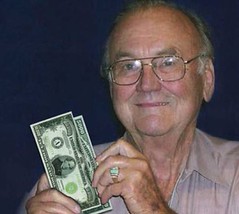 Harlan
White first became interested in numismatics in 1963. He owned a tire shop and would take walks every day at lunchtime. One day, he walked
into a coin shop, where he overheard a dealer asking $100 for a 1909-S V.D.B. Lincoln cent.
Harlan
White first became interested in numismatics in 1963. He owned a tire shop and would take walks every day at lunchtime. One day, he walked
into a coin shop, where he overheard a dealer asking $100 for a 1909-S V.D.B. Lincoln cent.
Harlan, not knowing anything about the value of rare coins, thought it was absurd that a penny could be worth $100. That night he told his wife, “I’m in the wrong business!” He immediately opened a part-time coin shop while still running his tire store. He would often go to the bank and buy bags of pennies and have his kids sort them by date.
In 1968, Harlan attempted to buy quantities of 1968 Proof sets, and successfully accumulated a massive amount in just two months. While on vacation in Alaska with his family, market demand for 1968 Proof sets skyrocketed, and when he returned home, he was able to sell his inventory at nearly threefold the cost. This was Harlan’s first big return, which catapulted him into the coin business full time. Harlan also had a passion for roses, hunting and fishing, as well as big-ticket coins and currency.
Mr. Holecek Remembers Harlan White
 I remembered reading about a well-known coin and currency dealer that was located in San Diego.
So, I called the Old Coin Shop and talked to Harlan White. I told him I collected coins as a child, and that I now had an interest in high
denomination US currency. I asked him if he had any “big bills” for sale, and if so did he have a lot of them to show me. He acknowledged
that he had some in stock but was very hesitant to disclose just how many he had and what types. I apologized for being so invasive of his
privacy, but I was going to be in town for only a few days at a tennis clinic and didn’t want to waste my time coming to see him if he only
had a few big bills to show me. He reassured me that I would not be wasting my time.
I remembered reading about a well-known coin and currency dealer that was located in San Diego.
So, I called the Old Coin Shop and talked to Harlan White. I told him I collected coins as a child, and that I now had an interest in high
denomination US currency. I asked him if he had any “big bills” for sale, and if so did he have a lot of them to show me. He acknowledged
that he had some in stock but was very hesitant to disclose just how many he had and what types. I apologized for being so invasive of his
privacy, but I was going to be in town for only a few days at a tennis clinic and didn’t want to waste my time coming to see him if he only
had a few big bills to show me. He reassured me that I would not be wasting my time.
DAY #1: I went in and was introduced to Harlan White. He welcomed me with a firm handshake, a warm smile and a slight twinkle in his eye. He reminded me of Santa Claus and I liked him from the very start. We walked back to his desk area near the back of the shop, sat down, and he began telling me about the wonderful world of high denomination U.S. currency - “big bills” in my layman’s terms. He quickly determined that I knew nothing about big bills. I had never physically seen one (only in pictures), I was not a dealer or collector that was trying to buy low and sell high, but rather I was just an amateur coin collector that was looking for something new, something different, something exciting. He sized me up correctly!
Harlan pulled out a $500 bill and handed it over to me to examine. WOW … a FIVE HUNDRED DOLLAR BILL! I had never seen one before, let alone handled one, and I was fascinated. President McKinley’s portrait, series 1928, a low serial number, and the words “WILL PAY TO THE BEARER ON DEMAND FIVE HUNDRED DOLLARS” – I was impressed! en I turned the bill over and looked at the less than impressive reverse, which reminded me of play money. Where are the battleships, monuments, and inspiring portraits that adorn much lesser bills? Harlan told me to ignore the reverse side, and said, “It’s the front side that counts – that’s where the money is!”
DAY #2: Sure enough, Harlan delivered upon his promise. He started out by saying, “If you thought the $500 bills were great, now meet President Cleveland!” He began by showing me one and then several more $1,000 bills in various conditions, series and Federal Reserve districts. ey all had President Cleveland’s portrait and they all said ONE THOUSAND DOLLARS. Now we were starting to talk about some serious money!
DAY #3 (New Year’s Day 1992): And that he did! We started by reviewing the $500 and $1,000 big bills he had already showed me. Piles of big bills covered the table and I just couldn’t believe the quantity and value of all these fantastic bills. But now onto the really good stuff …
Harlan retrieved from his safe a full pack of 100 numerical sequence serial numbered Series 1928 $500 bills … an original full pack of gorgeous bills that had been preserved and saved for over 60 years. Wow, I couldn’t believe what I was looking at! Harlan told me the story behind this unique treasure. He received a call from a lawyer in St. Louis who was probating and settling up the estate of a client that had recently died. In her safe deposit box the lawyer found personal documents, jewelry, gold coins and a brand new original pack of $500 bills.
Just when I thought it couldn’t get any better than this, Harlan told me he had been saving the “big boys” for last. He reached into his safe one last time and pulled out two bills. He said, “Meet President Madison and Mr. Chase.” WOW! A $5,000 bill and a $10,000 bill – now we were really talking BIG BILLS!! I couldn’t believe what I was holding in my hands. I didn’t even know that bills of this super high denomination had ever been printed. They were magnificent and I was totally blown away.
Yes, Harlan really did save the best for the last, and this fireworks finale left me breathless. As the “smoke cleared” I saw 358 $500 bills, 35 $1,000 bills, 1 $5,000, and 1 $10,000 big bills scattered around the table in front of me. I was overwhelmed and remembered how Harlan had told me I would not be wasting my time to come see what he had to show me. Was he ever right! But again, lunch break was over, and I had to get back to the tennis clinic.
And that is when Harlan leaned over and asked “So, which one do you want?” to which I excitedly replied, “I will take them ALL!” Harlan choked and just about fell off his chair onto the floor.
To read the complete article, see the online catalog:
http://media.stacksbowers.com/VirtualCatalogs/2015/Stacks-Bowers-Galleries/Mar2015-Baltimore/SBG_Mar2015_BaltCurr_Catalog_LR.pdf

HOWARD BERLIN VISITS BUCHAREST, ROMANIA
Following my visit to Riga and another overnight stay in Berlin, I landed in Bucharest - the country of Vlad III, Prince of Wallachia (aka Vlad the Impaler), who the world knows as Dracula. He was a member of the House of Drăculești, from which the Anglicized Dracula name evolved. As was told to me by my hotel’s concierge, Vlad III was the “founder” of Bucharest, first establishing his residence here. With my first visit to Romania, I have now been to 58 countries.
Wayne Homren already let the cat out of the bag, so to speak, by including my photo of the “blood bank” – the Banca Transilvania, at the airport in a recent issue of The E-Sylum. The bank is Romania’s third largest in terms of deposits. Although a member of the EU, Romania is not part of the eurozone and still uses the leu (lei, plural) as its currency, now featuring plastic polymer notes since 2005.
Museums in Europe are generally closed on Mondays, but I had to fit most of my intended museum visits into one day (Sunday) as all municipal and state museums are closed on both Mondays and Tuesdays and I was leaving for London Wednesday morning. Fortunately for me, there were a few exceptions. One of these, although not of numismatic interest, is perhaps Bucharest’s most popular tourist attraction (if not of all of Romania) is the People’s Palace (aka the Palace of Parliament).
It is the world's largest civilian building with an administrative function and is the second largest building in the world after the Pentagon in Washington, D.C. It was ordered built by Romanian Commie dictator Nicolae Ceausescu at a staggering cost of 3 billion euros. It was initiated in 1986 as a monument to the excesses of Ceausescu and his wife’s lavish lifestyle, which just about bankrupted the country. The palace has 12 floors and 1,100 rooms, but there is no mention of how many bathrooms there are.
Following protests and the shooting of some of the demonstrators in the Western part of the country, Ceausescu and his wife Elena were captured trying to flee the city and were quickly tried and executed on Christmas day 1989 while the palace was still under construction. The new government thought about stopping construction and demolishing it but found this would have cost just as much as it was to build it.
Sometimes I find numismatic-related items in unexpected places. In my hotel’s lobby (the Athénée Palace Hilton Bucharest) where the restaurant (Roberto’s) and the English Bar (apparently this was the preferred spot for spies during World War II) are located, on the walls are satirical renditions of U.S. and other foreign coins.
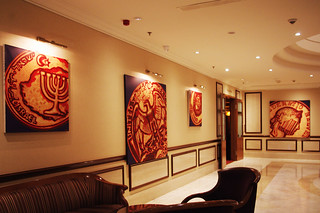
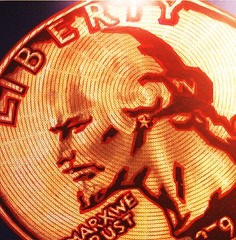
The primary numismatic exhibition here is the National Bank of Romania Museum, the country’s central bank. You need to arrange for an appointment to tour the museum at least three days in advance, and providing passport information, if you decide on visiting it. My hotel’s trusty concierge talked to someone at the Bank and was able to get me an appointment the day before I was to leave.
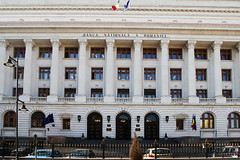 The Bank’s building, built in the neo-classical style, is actually two palaces back to back. The front
half is referred to as the “new palace,” having been built during World War II as an addition to the original building that was completed
in 1890. The impressive interior includes massive granite stairs and extensive use of white marble and chandeliers throughout.
The Bank’s building, built in the neo-classical style, is actually two palaces back to back. The front
half is referred to as the “new palace,” having been built during World War II as an addition to the original building that was completed
in 1890. The impressive interior includes massive granite stairs and extensive use of white marble and chandeliers throughout.
After clearing security, I was escorted on a tour of the museum by Ms. Ruxandra Onofrei who explained the history of the bank and the building we were in. I was allowed to photograph anything that was on display with the exception of one room which was entered through a bank vault-like door. In this room was a display of several gold ingots (looked like approximately 12 kg each) from the former Soviet Union, Switzerland, and the U.S. along with historical information panels on the walls.


Virtually the entire exhibition on the ground and second floors is spread out and uncluttered, with lots of space around the display cases. With text in both Romanian and English, displays feature money in use in Romania throughout history. Exhibited specimens included items, such as arrowheads, used as barter in ancient Romania (6-5th century BC); coins from Greece and Macedonia (4th-1st century BC); Koson (Transylvania) gold coins with a simple monogram (1st century BC); Roman Republic coins (2nd-1st century BC); Imperial Roman coins (1st-3rd century AD); late Roman coins (4th-5th century); Byzantine coins (6th-13th century); coins issued in the Romanian country (14th-18th century); coins issued in Moldova (14th-17th century); gold coins issued in the Romanian country (16th-17th century); Russian coins of Sadagura (18th century); coins issued in Transylvania (16th-18th century); Foreign coins that circulated in Romania (13th-19th century), which included an 1881 Morgan dollar and an 1898 gold double eagle; and 18th century silver and bronze coins from the Ottoman Empire, Austria, German States, Russia, France, Spain, and Netherlands. In an area by itself, is an exhibit illustrating the history of Romanian currency (coins and banknotes).
To read the earlier E-Sylum article, see:
NOTES FROM E-SYLUM READERS: MARCH 22, 2015 : Banca Transylvania, Bucharest,
Romania (www.coinbooks.org/esylum_v18n12a11.html)
NUMISMATIC TOUR OF EASTERN EUROPE AND RUSSIA
 The Polish-American Numismatic Society (PANS), based in Troy, Michigan, is currently
organizing its 2015 “Numismatic Educational Tour of Hands Across The Borders” of Eastern Europe and Russia, set to depart September 9 and
return to the United States on September 25.
The Polish-American Numismatic Society (PANS), based in Troy, Michigan, is currently
organizing its 2015 “Numismatic Educational Tour of Hands Across The Borders” of Eastern Europe and Russia, set to depart September 9 and
return to the United States on September 25.
The tour will start in Poland and cover Lithuania, Latvia, Estonia and Russia. The itinerary includes visiting the Numismatic Cabinet at the Hutten Czapski Money Museum in Krakow, Poland; The Royal Castle Numismatic Cabinet, the Warsaw Mint Museum and the Warsaw National Museum Numismatic Department in Warsaw; The Money Museum of the Bank of Lithuania in Vilnius, Lithuania; The National Museum in Riga, Latvia; The Bank of Estonia Museum in Tallinn, Estonia; The Hermitage Museum, The Numismatic Department in Saint Petersburg, Russia and The Pushkin State Museum in Moscow–along with various non-numismatic stops and tours.
Reservations and other arrangements are made through Amerpol Travel, also of Troy, Michigan. The price of the overland portion of the tour is US$3,700. All travelers are responsible for their own flights to Krakow, Poland. The estimated fare for a flight from Detroit to Krakow is $1,200. A valid passport is essential, and a Russian visa is required for entry into Russia. This visa must be applied for in advance, so plan ahead if you need to acquire either a visa or a passport.
To read the complete article, see:
Polish-American
Numismatic Society Organizing 2015 Tour of Eastern Europe, Russia
(www.coinweek.com/education/polish-american-numismatic-society-organizing-2015-tour-of-eastern-europe-russia/)
CROCODILES ON ROMAN COINS
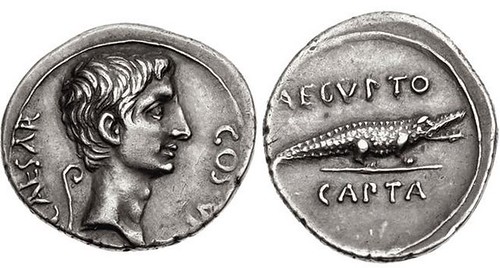
Silver denarius of Octavian
Crocodiles must have been just as exotic and fearsome to the people of the ancient world as they are to us today. To the Romans, the crocodile was most familiar as the emblem of Egypt, and its appearances on Roman coins were in reference to that province.
The first time a crocodile appeared on a Roman coin was in about 37 B.C. by an official who had authority over the Greek island of Crete and the North African region of Cyrenaica. He issued copper pieces signed CRAS or KPAΣ, leading most scholars to identify him as M. Licinius Crassus, the eldest son of the wealthy triumvir Crassus, who in 53 B.C. infamously had led about 20,000 Roman soldiers to their death in a poorly executed campaign against the Parthians.
As might be expected, crocodiles appear most often on coins produced in Egypt. Though the Romans struck untold millions of Egyptian coins with crocodiles, very few use this creature as the principal design. Indeed, those instances are limited to a minor denomination, the copper dichalkon.
These dichalkoi were issued by at least eight emperors from about 3 B.C. to A.D. 158, with the Emperor Hadrian supplementing the general issues with special dichalkoi honoring the administrative districts (nomes) in Egypt. All of these coins, however, are so rare that they must have been struck in small quantities.
The most common appearance of the crocodile on Egyptian coins was as a companion of Nilus, the god of the great river Nile, the main source of Egypt’s prosperity. Though crocodiles are not always present in coin designs portraying Nilus, they appear on many issues. The crocodile also accompanies Nilus on gold, silver and base metal coins struck in Rome by Hadrian to honor Egypt.
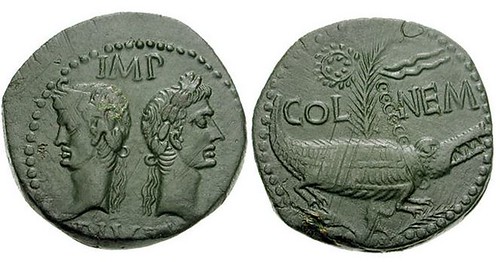
Copper coin of Nemausus
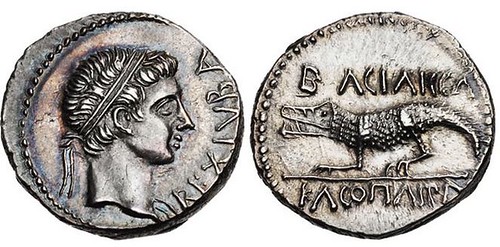
To read the complete article, see:
Crocodiles on Roman
coins most familiar as the emblem of the province of Egypt
(www.coinworld.com/insights/Crocodiles-on-Roman-coins-familiar-as-the-emblem-of-Egyptian-province.html#)
THE BOOK BAZARRE
THE SATYR AND THE NYMPH STATER
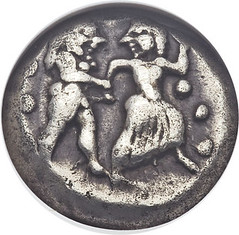
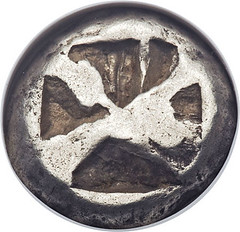
The ancient Greeks in the "civilized" southern portion of the peninsula regarded the people of the northern hinterlands, Macedon and Thrace in particular, as a wild, unrestrained bunch incapable of rational thought, entirely ruled by their lust for drinking, warfare and, of course, their rampant sexuality. Dionysus, the Olympian god of wine and drinking, is said to have hailed from these northern parts and his sacred rites, later called "Bacchanalia" (after his Roman counterpart Bacchus), were famously ribald.
As if to confirm the Greek view of their nature, the early coins struck by Thraco-Macedonian cities and tribes often feature ithyphallic (that is, sexually excited) satyrs chasing around, or carrying off, nubile young maidens, usually called "nymphs." Satyrs, the often-drunk and always erect companions of Dionysus, are depicted as nude, muscular men with pointed ears and a tail; the nymphs usually wear a flowing, diaphanous dress called a chiton. On the silver staters of the island city of Thasos, circa 520-450 BC, the satyr is actually carrying the nymph, who raises her hand in a gesture usually interpreted as a protest. It has been suggested that the Thasos coins actually depict a special dance that is part of Dionysic ritual (Dionysus was prominently worshipped in northern Greece and his portrait appears on later coins of Thasos).
Silver staters struck at the mint recently identified as Siris in Macedon, including this rare variety, depict a somewhat different scene — the nymph is fleeing the satyr, who reaches out to grasp her arm. Our coin, rendered with the full, rough vigor of the archaic Greek style, has an added feature not seen on other varieties: The nymph appears to grasp the Satyr's erect male member and looks back into his face with an expression that seems to say "gotcha!" It would appear to be a rare instance of the female "prey" getting the upper hand, so to speak, on her male pursuer.
The Siris ('Lete'). Ca. 525-480 BC. AR stater is being offered as part of our April 9 - 14 CICF World Coins & Ancient Coins Signature Auction. For more information and/or to be put on the list to receive a copy of the catalog, contact David S. Michaels (DMichaels@HA.com) or Sam Spiegel (SamS@HA.com).
To read the complete article, see:
Pompeia's Pick: "Satyrical" scene from Siris
(coins.ha.com/c/newsletter.zx?frame=no&id=4642#pompeia)
To read the auction lot description, see:
Lot 29028:
Ancients: MACEDON. Siris ("Lete"). Ca. 525-480 BC. AR stater
(coins.ha.com/itm/ancients/greek/ancients-macedon-siris-lete-ca-525-480-bc-ar-stater-19mm-996-gm-/a/3040-29028.s)
THE ETRUSCAN NUMBER SYSTEM ON COINAGE
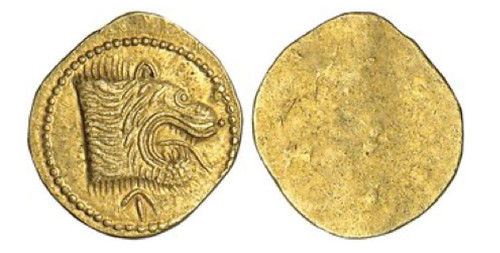
Etruscan Gold 50 Asses
The people who lived in Tuscany before the Romans are often described as “enigmatic” or “mysterious.” We know them as “Etruscans” from the name that the Romans called them; they called themselves “Rasna.” The last speakers of the Etruscan language probably died out in the first century of the common era. The consensus of linguistic scholars is that Etruscan is unrelated to other known languages. A single Etruscan book – a third-century BCE ritual calendar – survived in fragmentary strips because the linen it was written on was recycled in Ptolemaic Egypt to wrap a mummy. The Roman Emperor Claudius (r. 41-54 CE) wrote a 20-volume history of the Etruscans in Greek, now lost.
Blessed with fertile volcanic soil and abundant ores of iron and copper (along with forested hills providing charcoal to refine and work these metals), the Etruscans prospered, reaching a peak of cultural expression and political power in the sixth century BCE. A line of Etruscan kings ruled in Rome until they were overthrown about 509 BCE, and the Romans adopted many customs and institutions from Etruria.
Like their Roman neighbors, Etruscans used crude lumps of bronze (aes rude) or cast bars with a herringbone pattern as their earliest money. Like the Carthaginians across the sea in North Africa, Etruscans only adopted coinage after their Greek neighbors had been using it for centuries. How many centuries is a matter of dispute; some numismatists put the earliest coins as far back as 500 to 450 BCE, while others insist on dates around 300 (the only thing classical numismatists love more than ancient coins is arguing about chronology.)
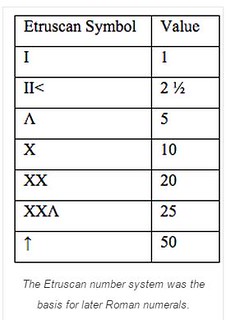 Etruscans may have been the first people to put marks of denomination on their coins. They used letters to
represents numbers – a system the Romans later modified as “Roman” numerals. Gold and silver were apparently denominated in units
corresponding to heavy cast bronze asses, which gradually declined from the “libral” standard base of 329 grams to the “sextantal” standard
of about 55 grams.
Etruscans may have been the first people to put marks of denomination on their coins. They used letters to
represents numbers – a system the Romans later modified as “Roman” numerals. Gold and silver were apparently denominated in units
corresponding to heavy cast bronze asses, which gradually declined from the “libral” standard base of 329 grams to the “sextantal” standard
of about 55 grams.
To read the complete article, see:
Those Darned Etruscans: Coins of the Rasna
(www.coinweek.com/ancient-coins/those-darned-etruscans-coins-of-the-rasna/)
THE STANDING CALIPH DINAR
 Anyone who is an avid collector of rare coins will understand the value of the Standing Caliph Dinar, which
is newly discovered to be of the first ever attempts of issuance of a promissory note by Abd Al-Malik bin Marwan the 5thUmayyad Caliph - a
fiat currency that had been circulated for few years during Abd Al-Malik`s reign in the 7th century.
Anyone who is an avid collector of rare coins will understand the value of the Standing Caliph Dinar, which
is newly discovered to be of the first ever attempts of issuance of a promissory note by Abd Al-Malik bin Marwan the 5thUmayyad Caliph - a
fiat currency that had been circulated for few years during Abd Al-Malik`s reign in the 7th century.
This rarest Umayyad gold coin shown in the picture is now in hand – explicitly declaring Damascus as a mint for the Standing Caliph Dinar (the “Dinar”), and recovering centuries after it has been long hidden. This Dinar minted by Caliph Abd Al-Malik engraved with valuable meanings is of the highest historical value between all.
Promissory Note Attempt by Caliph Abd Al-Malik
Back in a time where people would measure wealth through weight in gold, silver & bronze, it was really cumbersome to carry an exorbitant amount of coins lest they are mugged by robbers along the way or the efforts and time instead of the efficiency we have with banknotes today.
Caliph Abdul Malik attempted to do what was foreign to the minds of the people at that time which is by issuing a currency that would ease the trade, simplify money transfer and significantly enhance the economy. The currency is called the Standing Caliph Dinar which weighs 4.25g of gold but had a much higher value than its weight at its time. Thus, this sounds, at the first glance, weird and falls within the forbidden Gharar. But, on contrary, Abd Al-Malik was intelligent enough not to make such a mistake as the said extra virtual value was promised and guaranteed by the Caliphate. This guarantee is obvious on the Dinar as per the words struck on its Reverse, i.e, For the Slave of Allah Abd Al-Malik the Commander of the Believers. Moreover, the word “Dinar” is not struck on the same so the value thereof is open. In other words, this was, in effect, a promise to pay the bearer in coins by either gold or silver as per the corresponding value at the time of circulation, i.e, a promissory note.
Dr. Samir Al-Khadim the President of the Arab Institute for East & West Studies is the first to call the standing caliph dinars Aristocratic Dinars due to the value of the Dinar that was higher than its weight of gold during its circulation at that time.
In spite of the glorious vision of Caliph Abd Al-Malik, this promissory note was not meant to last. The Standing Caliph Dinar was canceled between 76AH-77AH (695-696) and that is the main reason behind the extreme rarity thereof.
To read the complete article, see:
The
Standing Caliph Dinar Minted in Damascus; Umayyad Promissory Note…
(http://yazaneltal.hubpages.com/hub/Discovery-of-The-Standing-Caliph-Dinar-Minted-in-Damascus-The-First-Ever-Promissory-Note)
THE BOOK BAZARRE
THE AMERICAN GEOGRAPHICAL SOCIETY LIBRARY
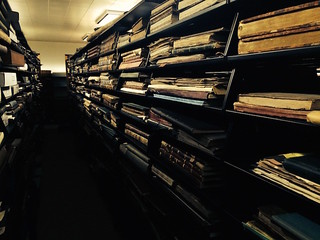 Within
the campus of University of Wisconsin-Milwaukee is a geographer’s treasure trove: over a million artifacts from the American Geographical
Society, one of the most incredible collections of maps, atlases and globes to be found in America.
Within
the campus of University of Wisconsin-Milwaukee is a geographer’s treasure trove: over a million artifacts from the American Geographical
Society, one of the most incredible collections of maps, atlases and globes to be found in America.
It's an inconspicuous home for a storied collection: this is the final resting place of the library of the illustrious American Geographical Society. Once a powerhouse of exploratory resources, the organization had fallen on hard times in the late 1970s. The private donations and corporate funding on which they had been reliant, had reduced to a trickle, and the Society was forced to sell its imposing neo-classical headquarters in Manhattan’s Washington Heights.
Eventually downsizing to a small rental office in Brooklyn, the Society was adamant that its unparalleled collection should be kept intact. Resisting the temptation to sell off its valuable archive, including the remarkable signed AGS Fliers and Explorers Globe, they undertook a nationwide search for a suitable home. As current AGS President, Professor Jerry Dobson explains, “The truth is that our revenues didn’t allow us to take care of the collection in a proper manner, so we held a national competition for a suitable repository.”
Faculty members of the geography department at UWM heard what was happening and applied. The University itself was barely 20 years old, but had a brand new library building large enough to house the entire collection. The New York States Attorney office wasn’t happy that the rich cultural heritage and treasures of the Society would be leaving the State of New York, but with no other viable option to take the collection as a whole, the decision was taken to send the collection to Wisconsin in 1978.
It took 16 trucks to move the vast collection, where it lives and is actively curated today in the Golda Meir Library. Incredibly, the precious collection is publicly available.
Entering the library, the first thing that strikes you is the amount of globes—there are hundreds of globes on permanent display, including one dating as early as 1613. The largest globe is a rare example of the giant “President’s Globe”. Made during World War II by the Office of Strategic Services (the OSS was the predecessor of the CIA), the 50 inch diameter globes were made for President Roosevelt and Prime Minister Winston Churchill. Weighing over 700 pounds, and thought to be the most detailed and accurate globes made up until that point, the intent was that FDR and Churchill would have an identical reference source as they plotted their war plans. Roosevelt kept the giant globe next to his desk in the Oval office, and it can now be found in his former home in Hyde Park.
To read the complete article, see:
INSIDE THE MOST AMAZING MAP LIBRARY
THAT YOU'VE NEVER HEARD OF (www.atlasobscura.com/articles/the-most-amazing-map-library-that-you-ve-never-heard-of)
PRESIDENTIAL CANDIDATE RAND PAUL COLLECTED COINS
Paul's wife went on to tell the story of Paul's upbringing, which makes no direct mention of Paul’s famous father -- former presidential candidate Ron Paul who was in attendance but did not speak at Tuesday's announcement -- and instead focuses on Paul’s relationship to his grandmother, who lost her vision as she aged. Paul was an avid coin collector as a child, and it was a hobby he shared with his grandmother.
"As her eyesight began to fail, he became her eyes to spy the faint mint marks on the coins as they would go through them together," Kelley says in the video. "Rand never forgot how sad it was for him to watch his grandmother lose her vision and that really cemented for him his desire to be an ophthalmologist."
To read the complete article, see:
Rand Paul Makes 2016 White House
Bid Official: 'We Have Come To Take Our Country Back'
(http://abcnews.go.com/Politics/rand-paul-makes-2016-white-house-bid-official/story?id=30135296)
TODDLER DROPS VICE PRESIDENT BIDEN'S COIN INTO VENT
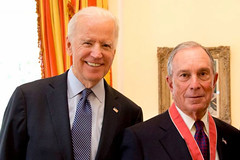 At Michael Bloomberg’s ceremony at the British Embassy in Washington, DC, where he was awarded an
honorary knighthood by Queen Elizabeth, Joe Biden took an immediate liking to Mike’s 1-year-old grandson, Jasper, who was there with his
mom, Georgina.
At Michael Bloomberg’s ceremony at the British Embassy in Washington, DC, where he was awarded an
honorary knighthood by Queen Elizabeth, Joe Biden took an immediate liking to Mike’s 1-year-old grandson, Jasper, who was there with his
mom, Georgina.
A witness said, “The VP was so natural and sweet with him . . . at one point he even took Jasper’s pacifier out of his mouth and jokingly put it in his own. Just before he put Jasper down, he slipped him a special vice- presidential gold coin. Jasper took it and promptly walked straight over to a floor vent and threw in the coin through the open slots. Everyone gasped.”
Biden’s touchy-feely antics have inspired countless GIFs. But this might be the first time Biden’s been demeaned by a baby, albeit an undoubtedly bright one.
The source added that embarrassment over the coin was averted during the lunch that followed. An embassy employee ripped the vent up and dug up the coin.
To read the complete article, see:
Bloomberg’s grandson embarrasses Joe Biden
(http://pagesix.com/2015/04/09/bloombergs-grandson-embarrasses-joe-biden/)

